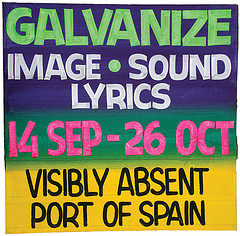Wednesday, April 19, 2006
Imaginary Roads 1:6
It was impossible to not be surprised by the physical graciousness of the city, even though this was described in every account of Georgetown he'd read. The wide streets and their generous grid, the low line of the buildings, few rising to more than three stories, gave a sense of spaciousness; yet as he walked to his appointments he found that this was the rare city where things were actually closer than they appeared on the map.
It was the buildings themselves he most marvelled at, the older ones, built of wood and painted white, their fretwork and shuttered windows letting in the breeze from the north-east, delicate as houses made of paper, their banks of slender shutters like frills cut with tiny scissors. He thought of them as white ships floating across the waterlogged land, lined up in graceful flotillas.
But many of these lovely structures were decrepit, their paint peeling, boards warped, exterior staircases fallen away, weeds sprouting from balconies. Even this disrepair could be poignant and picturesque. And at the feet of these buildings, or just outside their walls, the open canals designed to channel the water that would otherwise submerge the city were full of slime and garbage, overgrown with water-weeds; water sat stagnant everywhere in the city, full of mosquito larvae or small fish. This elaborate hydraulic system first devised by the Dutch, by which the city was protected at high tide by the kokers, and drained into the Demerara at low tide, had been allowed to decay for decades. Canals were clogged, kokers warped or rusted shut, and now the foul wastewater was trapped among the streets. A septic smell lingered through Georgetown, like a reminder of failure.
A city built below sea level is in constant danger of drowning. A city built of wood is in constant danger of burning. Every day as he walked to and fro he saw gaps between buildings, empty except for a few charred timbers or concrete pillars that once supported wooden floors. If one of these wooden buildings caught fire, it burned so quickly there was almost no chance it could be saved.
Two months before he arrived Guyana, in fact on Christmas Day, the Sacred Heart church on Main Street, one of the city's landmarks, was destroyed during mass by a fire that started in the nativity crib. As the congregation sang the final hymn of the service, a small lightbulb sparked and exploded, and the straw that had been arranged around the figures in the nativity scene--the infant Jesus, the kneeling Virgin, Joseph with his staff, the ox and the donkey and the lambs--caught alight.
The church interior had just been repainted, with oil paint, and the building could not have been more flammable. In twenty minutes, he was told, the hundred-and-forty-three-year-old church was consumed by fire, its two towers, its Italianate west facade, the school behind it, and the parish records, with their details of the births, marriages, and deaths of five generations of the Portuguese community who had built Sacred Heart. Later he saw a photograph of the fire, the building's main timbers stark as a skeleton in the inferno. He often walked past the orb-topped gateposts that had once admitted worshippers to the church; now they led to an expanse of rubble among the stone foundations.
One day, as he returned from an errand at the bottom of Main Street, he noticed the Sacred Heart gate was no longer padlocked, and he went in. No one in the street paid him any attention. In the rubble he found fragments of wood now reduced to charcoal, shattered glass, and pieces of tin with a beaded pattern beaten into them. Anything of value that survived the blaze--if anything could have survived the blaze--had long been taken away, and fresh weeds were sprouting up through the small debris.
It was impossible to not be surprised by the physical graciousness of the city, even though this was described in every account of Georgetown he'd read. The wide streets and their generous grid, the low line of the buildings, few rising to more than three stories, gave a sense of spaciousness; yet as he walked to his appointments he found that this was the rare city where things were actually closer than they appeared on the map.
It was the buildings themselves he most marvelled at, the older ones, built of wood and painted white, their fretwork and shuttered windows letting in the breeze from the north-east, delicate as houses made of paper, their banks of slender shutters like frills cut with tiny scissors. He thought of them as white ships floating across the waterlogged land, lined up in graceful flotillas.
But many of these lovely structures were decrepit, their paint peeling, boards warped, exterior staircases fallen away, weeds sprouting from balconies. Even this disrepair could be poignant and picturesque. And at the feet of these buildings, or just outside their walls, the open canals designed to channel the water that would otherwise submerge the city were full of slime and garbage, overgrown with water-weeds; water sat stagnant everywhere in the city, full of mosquito larvae or small fish. This elaborate hydraulic system first devised by the Dutch, by which the city was protected at high tide by the kokers, and drained into the Demerara at low tide, had been allowed to decay for decades. Canals were clogged, kokers warped or rusted shut, and now the foul wastewater was trapped among the streets. A septic smell lingered through Georgetown, like a reminder of failure.
A city built below sea level is in constant danger of drowning. A city built of wood is in constant danger of burning. Every day as he walked to and fro he saw gaps between buildings, empty except for a few charred timbers or concrete pillars that once supported wooden floors. If one of these wooden buildings caught fire, it burned so quickly there was almost no chance it could be saved.
Two months before he arrived Guyana, in fact on Christmas Day, the Sacred Heart church on Main Street, one of the city's landmarks, was destroyed during mass by a fire that started in the nativity crib. As the congregation sang the final hymn of the service, a small lightbulb sparked and exploded, and the straw that had been arranged around the figures in the nativity scene--the infant Jesus, the kneeling Virgin, Joseph with his staff, the ox and the donkey and the lambs--caught alight.
The church interior had just been repainted, with oil paint, and the building could not have been more flammable. In twenty minutes, he was told, the hundred-and-forty-three-year-old church was consumed by fire, its two towers, its Italianate west facade, the school behind it, and the parish records, with their details of the births, marriages, and deaths of five generations of the Portuguese community who had built Sacred Heart. Later he saw a photograph of the fire, the building's main timbers stark as a skeleton in the inferno. He often walked past the orb-topped gateposts that had once admitted worshippers to the church; now they led to an expanse of rubble among the stone foundations.
One day, as he returned from an errand at the bottom of Main Street, he noticed the Sacred Heart gate was no longer padlocked, and he went in. No one in the street paid him any attention. In the rubble he found fragments of wood now reduced to charcoal, shattered glass, and pieces of tin with a beaded pattern beaten into them. Anything of value that survived the blaze--if anything could have survived the blaze--had long been taken away, and fresh weeds were sprouting up through the small debris.
Subscribe to:
Post Comments (Atom)









No comments:
Post a Comment